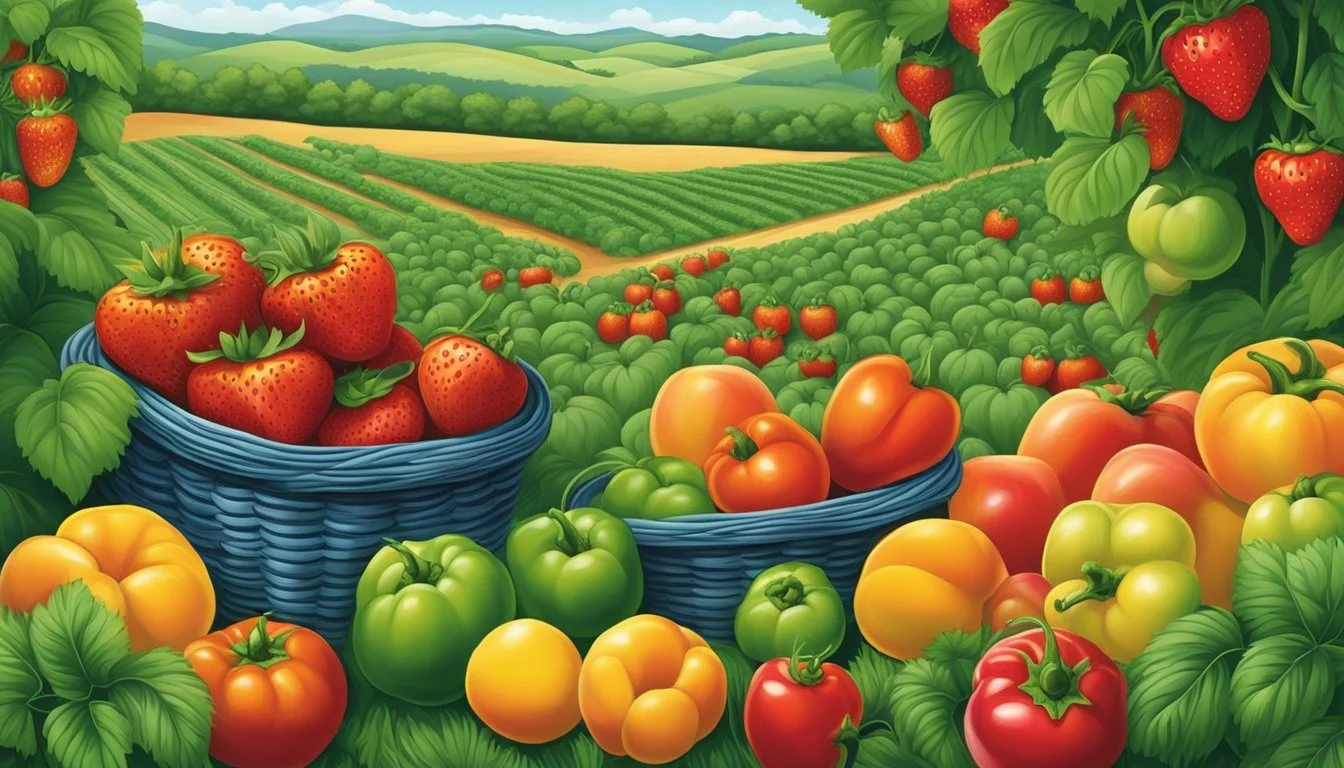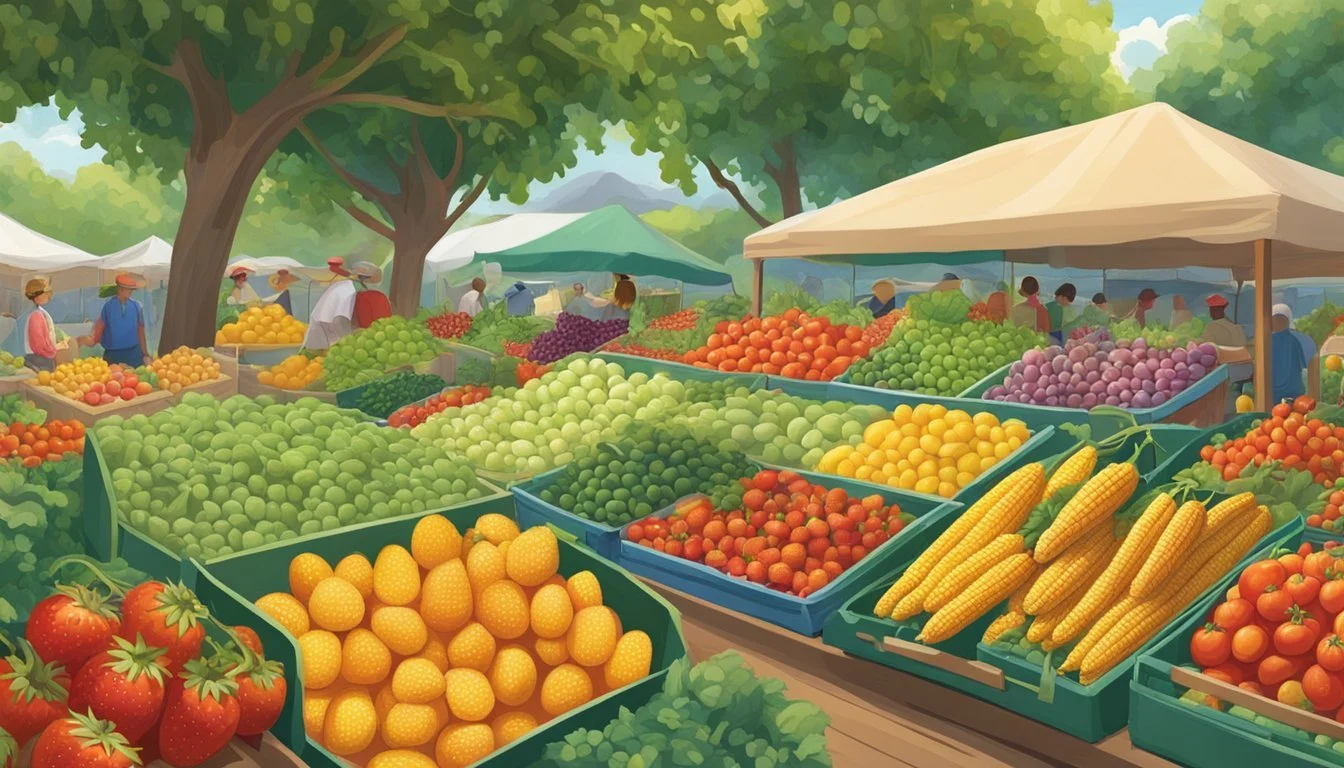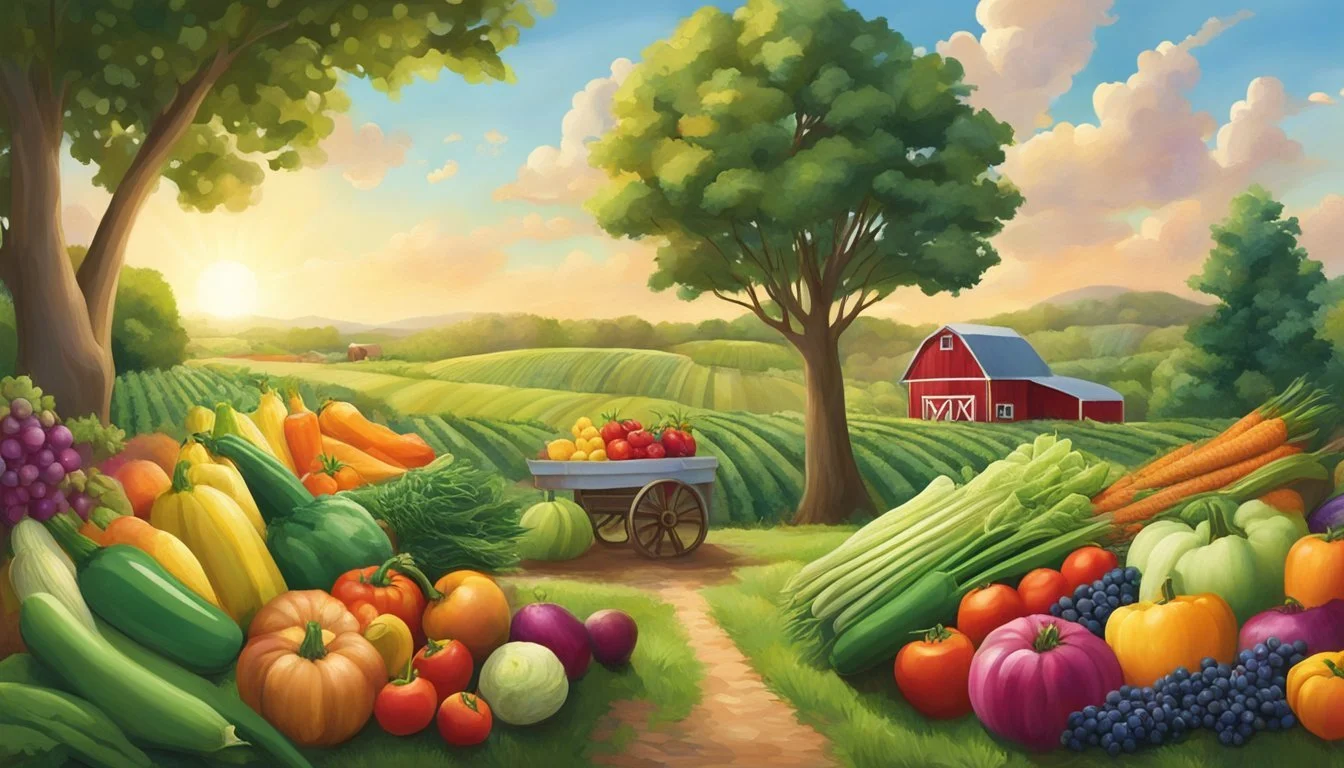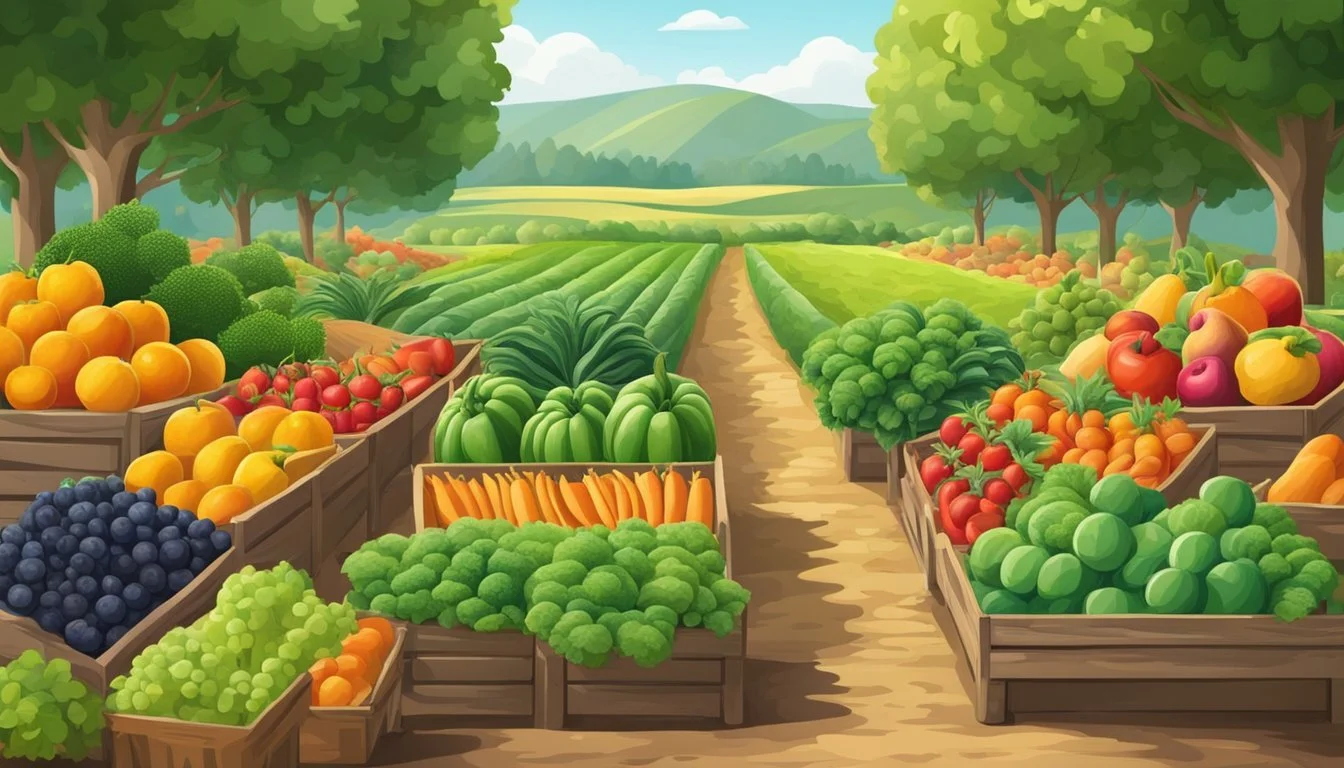Virginia Seasonal Fruit & Veg Guide
Your Ultimate Year-Round Companion
Embracing the rhythm of the seasons, Virginia offers a cornucopia of fresh produce throughout the year, with farms bustling as they grow and harvest a variety of fruits and vegetables. The Farm to Table movement enriches the local cuisine by ensuring that what reaches the plate is as fresh, nutritious, and flavorful as possible. This guide navigates through the seasonal availability of produce in Virginia, aiding both consumers and chefs in making informed choices that support local agriculture and reduce the carbon footprint associated with long-distance food transport.
Understanding the seasonal cycles is crucial for anyone looking to enjoy fresh, locally-sourced fruits and vegetables in Virginia. Different regions within the state may have slight variations in growing seasons due to their unique climates, but a general pattern of availability is apparent. Spring heralds the arrival of tender greens and crisp asparagus (What wine goes well with asparagus?), while summer offers a bounty of berries, peaches, and tomatoes. Fall brings an abundance of apples and root vegetables, and even in the colder months, hearty greens and stored produce like winter squash are available.
For the Virginia resident or visitor interested in a farm-to-table approach, this guide becomes an essential tool, fostering a connection to the land and its produce. Choosing seasonal items not only heightens the dining experience but also supports local farmers who are stewards of the state's agricultural heritage. This ensures the continuation of farming traditions and contributes to a sustainable food system within the Commonwealth of Virginia.
What’s in Season in Virginia Right Now?
Understanding Seasonality
Understanding the seasonality of produce is essential as it affects flavor, availability, and the variety of fruits and vegetables one can enjoy through the year. It also guides the regional farm-to-table movement in Virginia.
Benefits of Seasonal Eating
Seasonal eating refers to the practice of consuming fruits and vegetables around the time they are harvested. This habit maximizes the flavor and nutritional value of produce. When crops are picked at their peak ripeness, not only do they taste better, but they also offer higher levels of vitamins and antioxidants. Additionally, seasonal produce can be more affordable due to the abundance and decreased transportation costs.
Availability of seasonal produce encourages local economies as consumers tend to purchase from nearby farmers’ markets and growers. This shortens the supply chain and supports Virginia's agricultural community, further ensuring fresher, tastier, and more nutritious food on the table.
Virginia's Growing Seasons
Virginia experiences four distinct growing seasons, each offering different crops:
Spring: This season provides an abundance of greens like lettuce and spinach, as well as root vegetables such as radishes and turnips.
Summer: Marked by the availability of a wide variety of fruits including berries, peaches, and melons, summer ensures a colorful selection on one's plate.
Fall: The harvest season, where apples and pears are abundant; root vegetables make a comeback, alongside pumpkins and gourds.
Winter: While there is a decrease in crop variety, many hearty vegetables like kale and Brussels sprouts (how long do brussels sprouts last?)withstand the cold.
The table below highlights produce typically in season in Virginia:
Season Fruits Vegetables Spring Strawberries, Cherries (how long do cherries last?) Asparagus, Peas Summer Blueberries, Peaches, Melons Tomatoes, Corn Fall Apples, Pears Pumpkins, Beets Winter -- Kale, Brussels Sprouts
Each region within Virginia may experience slight variations in growing seasons due to differences in climate and geography, impacting the exact timing of when certain produce is at its peak.
Spring Harvest
The spring season in Virginia offers a refreshing assortment of fruits and berries, alongside a diverse array of vegetables. They emphasize not only the state's agricultural richness but also the joy of farm-to-table freshness.
Fruits and Berries in April and May
Strawberries: Come April, strawberries begin to ripen, offering sweet and juicy flavors peaking in May.
Cherries: Cherry blossoms give way to ripe cherries towards the end of spring, marking a short but delectable season.
Vegetables Ready in Spring
Asparagus: One of spring's first arrivals, asparagus shoots up in April, providing a tender and flavorful vegetable option.
Greens: A variety of greens like spinach and lettuce thrive in the cool, early months of spring.
Herbs: Spring also beckons the start of herb planting, with favorites like parsley and cilantro flourishing.
Summer Abundance
Summer in Virginia highlights the peak of flavor and variety with fruits and vegetables that are ripe for the picking. These months offer a bounty that is fresh, full of taste, and often best enjoyed at their peak of freshness.
Juicy Fruits of June and July
Throughout June and July, Virginia's orchards and fields are abundant with juicy fruits. Blueberries, one of summer’s superstars, arrive in June and continue to delight through July. They are joined by peaches, bursting with flavor, best enjoyed fresh off the tree or in homemade pies and preserves.
Blueberries: June to July
Peaches: June to August
Summer Vegetables and Greens
Summer also brings an array of vegetables and greens that thrive in Virginia's warm climate. Tomatoes, a staple in many summer dishes, ripen into a full spectrum of colors and varieties during these months. They share the stage with corn, a versatile crop that is synonymous with summer and becomes a highlight at every cookout.
Tomatoes: June to September
Corn: July to September
Late Summer Harvest
As summer progresses into August, the focus shifts to the late summer harvest. Melons become the stars of the show, with their refreshing qualities and sweet taste. Cantaloupes and watermelons are predominant, offering a cool respite from the summer heat and are perfect for picnics and barbecues.
Melons: August to September
Virginia's summer months are truly a celebration of fresh, local produce that goes from farm to table with minimal delay, ensuring that residents and visitors alike can enjoy the full flavor and nutritional benefits of what the season has to offer.
Fall Selections
As the air turns crisp and the leaves begin to turn, Virginia's farms offer an abundant array of fall fruits and vegetables. Consumers can enjoy both the familiar and the unique as the harvest yields hearty produce perfect for autumnal meals.
Autumn Fruits
Apples and pears are the standout fruits in the fall season. Virginia’s apple varieties come into fruition with options like Fayette and York that are perfect for both eating fresh and baking. One can explore local farmers' markets for the freshest picks. Pears, with their sweet and soft texture, offer another fall favorite often found in local orchards and are ideal for both desserts and savory pairings.
Apples: Fayette, York, Fuji
Pears: Bartlett, Bosc
Root Vegetables and Squash
With the arrival of fall, root vegetables and winter squash take center stage on Virginia's tables. Sweet potatoes and pumpkins are among the most anticipated of the seasonal bounty. Their versatility means sweet potatoes are as likely to be found in a pie as they are in a savory stew. Likewise, pumpkins are celebrated beyond the traditional pies; they also add depth to soups and roasted vegetable medleys.
Sweet Potatoes: Covington, Beauregard
Winter Squash: Butternut, Acorn
Pumpkin: Classic varieties for carving and cooking
Winter Offerings
Winter in Virginia boasts a robust selection of fruits and vegetables, thanks to cold-hardy varieties and greenhouse cultivation. Even during the chill of the season, consumers can delight in fresh, flavorful, and nutritious produce.
Cold Hardy Varieties
Winter months do not deter certain crops that thrive in Virginia's cooler temperatures. December, the heart of winter, still yields an assortment of produce:
Greens: Kale, spinach, and collards are quite resilient and continue to grow in colder weather.
Brussels Sprouts: These are at their peak during the winter months, with a sweet, nutty flavor enhanced by the frost.
Cabbage: A versatile vegetable that remains available throughout winter, cabbage is a staple in hearty seasonal dishes.
These vegetables do not only survive the cold—they often become sweeter and tastier after a frost, making them a prized component of winter cuisine.
Greenhouse Grown Produce
Farmers leverage greenhouse technologies to extend the growth period of various fruits and vegetables beyond their traditional outdoor growing seasons. Produce typically grown in Virginia greenhouses during winter includes:
Tomatoes
Cucumbers
Herbs
Lettuces
The controlled environment of a greenhouse provides the necessary warmth and protection, enabling these plants to flourish despite the frosty weather outdoors. This method ensures a steady supply of fresh produce to local markets, restaurants, and dinner tables.
Local Farming Practices
Virginia farms are known for utilizing a mix of agricultural practices to ensure a sustainable and abundant production of fruits and vegetables. Two primary approaches are organic and sustainable agriculture and conventional farming, each playing a significant role in the state's crop availability.
Organic and Sustainable Agriculture
Many Virginia farms have embraced organic farming, a method that avoids synthetic pesticides and fertilizers, thus promoting ecological balance and conserving biodiversity. Sustainable practices are also common, with farmers focusing on soil health, water conservation, and reduced carbon emissions. These practices not only support the environment but also aim to produce healthier, more nutritious produce.
Crop Availability: Due to the nature of organic and sustainable agriculture, crop availability can vary, with certain fruits and vegetables being seasonal.
Conventional Farming in Virginia
Conventional farming remains prevalent in Virginia. This approach often involves the use of synthetic chemicals and mechanized equipment, which can lead to high yield and efficient farming operations.
State Support: Virginia’s Department of Agriculture and Consumer Services supports conventional farmers with research and programs designed to enhance farming efficiency and productivity.
Farms: Despite the use of synthetic inputs, many farms in the state are still family-owned and contribute significantly to local economies.
Finding Local Produce
Virginia offers an abundance of locally grown fruits and vegetables throughout the year. Here's how consumers can connect directly with fresh produce either right from the farm or at a nearby location.
Farmer's Markets and Farm Stands
Farmers' Markets are prevalent in many Virginia cities, hosting a variety of local producers. These markets are typically held weekly and are a treasure trove for seasonal produce. Local farm stands operate on the farms themselves and often sell what's harvested that day for peak freshness.
Example Markets:
Charlottesville City Market
Williamsburg Farmers Market
Benefits: Freshness, supporting local farmers, seasonal variety
Community Supported Agriculture (CSA)
CSAs allow consumers to subscribe to the harvest of a certain farm or group of farms. By purchasing a share of the produce, members receive regular, often weekly, boxes or baskets of seasonal produce throughout the farming season.
How it works:
Subscription or membership
Regular pick-up or delivery
Benefits: Direct farm support, exposure to new produce, learning about local agriculture
Grocery Stores and Supermarkets
Many Virginia grocery stores and supermarkets stock local produce, especially when it's in season. Look for signage that indicates "Virginia Grown" or similar to identify local options.
Local Sections:
Often marked with farm information
Includes seasonal fruits and vegetables
Benefits: Convenience, broader selection, year-round availability
Preparation and Storage Tips
In Virginia's farm-to-table scene, knowing how to properly prepare and store fresh produce is key to maintaining flavor and extending shelf life. The following guidelines are crafted to ensure that fruits and vegetables retain their optimum taste and variety through appropriate cleaning and storage methods.
Cleaning and Storing Fresh Produce
When handling fresh fruits and vegetables, it is essential to wash them under running water to remove any dirt or potential residues. For items like brussels sprouts, which are available from October through December, removing them from the stalk and storing them in a loose bag in the fridge helps them last longer. Root vegetables, such as carrots, which are available year-round, should be stored in a cool, dark place.
Fruits like cantaloupes, in season during July and August, should be stored on the counter until ripe and then moved to the fridge. This transition ensures they maintain their flavor. Conversely, butter beans have a limited season from July to August and should be shelled, then refrigerated to preserve their freshness.
Preserving Seasonal Bounty
To preserve the seasonal bounty, proper storage techniques must be tailored to each produce type. Vegetables like cabbages, available from May through December, stay fresh when kept in a humid section of the refrigerator. Cauliflower, found from October through December, can be stored in a similar fashion.
For short-lived produce such as sugar snap peas, which typically last 4-5 days, refrigeration in a plastic bag is recommended, and usage is best as soon as possible. This approach captures their sweet flavor and crispness. Utilizing the freezer for fruits and vegetables that won't be eaten in time is a savvy method to avoid waste and save money, locking in freshness for later use.
Employing these specific storage strategies for fruits and vegetables enhances the farm-to-table experience by preserving the quality and diversity of Virginia's seasonal offerings.
Seasonal Recipes and Pairings
Virginia's seasonal produce offers a diverse palette for the culinary enthusiast, and pairing these ingredients can enhance their natural flavors. The following recipes celebrate the freshness and taste of local fruits and vegetables, matched to create satisfying meals.
Spring and Summer Recipes
Spring in Virginia brings a burst of fresh flavors. A vibrant Spring Pea and Mint Soup harnesses the sweetness of just-picked peas, with the coolness of mint, providing a refreshing starter. Pair this with a Strawberry Spinach Salad, featuring field-fresh spinach and ripe strawberries, tossed in a light balsamic vinaigrette and topped with slivers of toasted almonds.
For Summer, when the heat brings corn and tomatoes to their peak, a Charred Corn and Tomato Salsa serves as a versatile condiment. The smokiness of the grill accentuates the corn's natural sweetness, while the acid from ripe tomatoes provides a balanced contrast. This salsa pairs beautifully with grilled fish or atop greens for a light salad. Another seasonal hit can be a Chilled Cucumber Soup with diced, crunchy cucumbers and aromatic dill served alongside a sandwich of farm-fresh tomatoes and crisp lettuce on artisanal bread.
Autumn and Winter Dishes
As the weather cools in Autumn, root vegetables take center stage. A Roasted Root Vegetable Medley combining carrots, parsnips, and sweet potatoes, seasoned with rosemary, thyme, and a touch of maple syrup, creates a hearty accompaniment to any main course. A Kale and Apple Salad, with tender kale and crisp apples, dressed in a cider vinaigrette, brings together the flavors of fall.
In the Winter, chefs can feature Collard Greens (how long do collard greens last?) braised with garlic and onions, adding a touch of apple cider vinegar for brightness. They pair exceptionally well with roasted meats (What wine goes well with roasted meats?). Another favorite is Butternut Squash Soup, where the natural creaminess of the squash is accented with a hint of nutmeg (how long does nutmeg last?) and can be topped with roasted pumpkin seeds (how long do pumpkin seeds last?) for a satisfying crunch.
Community and Resources
In Virginia, the farm-to-table movement is enriched by a robust network of community efforts and online resources. These initiatives are dedicated to education, connection, and supporting local agricultural systems.
Educational Workshops and Events
Virginia's agricultural agencies and local farming communities frequently organize workshops and events aimed at educating the public and farmers about sustainable practices and the benefits of farm-to-table eating. These gatherings are pivotal in fostering a greater understanding of Virginia's seasonal produce calendar and encouraging community engagement with local food systems.
Workshops: They often cover topics such as organic farming, soil health, and harvest techniques.
Events: Seasonal fairs and farmer's markets serve as both educational and commercial venues.
Food Blogs and Online Communities
Food enthusiasts and advocates in Virginia have taken to the internet to create a vibrant online community. Through blogs and social media platforms like Facebook, they share tips, recipes, and information on seasonal availability of produce.
Blogs: They offer a wealth of knowledge, from preparing seasonal dishes to understanding the intricacies of local food sourcing.
Facebook Groups: These groups serve as a digital meeting place where Virginians exchange information, plan events, and support each other's efforts to buy and eat locally-grown produce.












